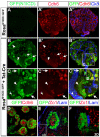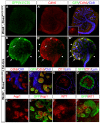Notch pathway activation can replace the requirement for Wnt4 and Wnt9b in mesenchymal-to-epithelial transition of nephron stem cells
- PMID: 21852398
- PMCID: PMC3171224
- DOI: 10.1242/dev.070433
Notch pathway activation can replace the requirement for Wnt4 and Wnt9b in mesenchymal-to-epithelial transition of nephron stem cells
Abstract
The primary excretory organ in vertebrates is the kidney, which is responsible for blood filtration, solute homeostasis and pH balance. These functions are carried out by specialized epithelial cells organized into tubules called nephrons. Each of these cell types arise during embryonic development from a mesenchymal stem cell pool through a process of mesenchymal-to-epithelial transition (MET) that requires sequential action of specific Wnt signals. Induction by Wnt9b directs cells to exit the stem cell niche and express Wnt4, which is both necessary and sufficient for the formation of epithelia. Without either factor, MET fails, nephrons do not form and newborn mice die owing to kidney failure. Ectopic Notch activation in stem cells induces mass differentiation and exhaustion of the stem cell pool. To investigate whether this reflected an interaction between Notch and Wnt, we employed a novel gene manipulation strategy in cultured embryonic kidneys. We show that Notch activation is capable of inducing MET in the absence of both Wnt4 and Wnt9b. Following MET, the presence of Notch directs cells primarily to the proximal tubule fate. Only nephron stem cells have the ability to undergo MET in response to Wnt or Notch, as activation in the closely related stromal mesenchyme has no inductive effect. These data demonstrate that stem cells for renal epithelia are uniquely poised to undergo MET, and that Notch activation can replace key inductive Wnt signals in this process. After MET, Notch provides an instructive signal directing cells towards the proximal tubule lineage at the expense of other renal epithelial fates.
Figures







References
-
- Barak H., Boyle S. C. (2011). Organ culture and immunostaining of mouse embryonic kidneys. Cold Spring Harb. Protoc. 2011, doi: 10.1101/pdb prot5558 - PubMed
-
- Barasch J., Yang J., Ware C. B., Taga T., Yoshida K., Erdjument-Bromage H., Tempst P., Parravicini E., Malach S., Aranoff T., et al. (1999). Mesenchymal to epithelial conversion in rat metanephros is induced by LIF. Cell 99, 377-386 - PubMed
-
- Blair S. S. (1996). Notch and Wingless signals collide. Nature 271, 1822-1823 - PubMed
-
- Boyle S., Shioda T., Perantoni A. O., de Caestecker M. (2007). Cited1 and Cited2 are differentially expressed in the developing kidney but are not required for nephrogenesis. Dev. Dyn. 236, 2321-2330 - PubMed
-
- Boyle S., Misfeldt A., Chandler K. J., Deal K. K., Southard-Smith E. M., Mortlock D. P., Baldwin H. S., de Caestecker M. (2008). Fate mapping using Cited1-CreERT2 mice demonstrates that the cap mesenchyme contains self-renewing progenitor cells and gives rise exclusively to nephronic epithelia. Dev. Biol. 313, 234-245 - PMC - PubMed
Publication types
MeSH terms
Substances
Grants and funding
LinkOut - more resources
Full Text Sources
Other Literature Sources
Medical
Molecular Biology Databases
Miscellaneous

